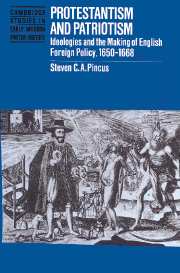Book contents
- Frontmatter
- Contents
- Acknowledgments
- List of abbreviations
- 1 Introduction
- Part I The rod of the Lord: ideology and the outbreak of the First Anglo-Dutch War
- Part II To unite against the common enemy: the 1654 Treaty of Westminster and the end of apocalyptic foreign policy
- Part III Popery, trade, and universal monarchy: ideology and the outbreak of the Second Anglo-Dutch War
- Part IV The Medway, Breda, and the Triple Alliance: the collapse of Anglican Royalist Foreign Policy
- 17 Historiographical overview
- 18 The circulation of news and the course of the war
- 19 The popular understanding of the war
- 20 The government's war aims
- 21 An Orangist revolution
- 22 Victory denied and wartime consensus shattered
- 23 The rise of political opposition
- 24 The road to Chatham: the decision not to send out a battle fleet
- 25 The demise of Anglican Royalist foreign policy
- Conclusion
- Bibliography
- Index
- Titles in the series
19 - The popular understanding of the war
Published online by Cambridge University Press: 01 October 2009
- Frontmatter
- Contents
- Acknowledgments
- List of abbreviations
- 1 Introduction
- Part I The rod of the Lord: ideology and the outbreak of the First Anglo-Dutch War
- Part II To unite against the common enemy: the 1654 Treaty of Westminster and the end of apocalyptic foreign policy
- Part III Popery, trade, and universal monarchy: ideology and the outbreak of the Second Anglo-Dutch War
- Part IV The Medway, Breda, and the Triple Alliance: the collapse of Anglican Royalist Foreign Policy
- 17 Historiographical overview
- 18 The circulation of news and the course of the war
- 19 The popular understanding of the war
- 20 The government's war aims
- 21 An Orangist revolution
- 22 Victory denied and wartime consensus shattered
- 23 The rise of political opposition
- 24 The road to Chatham: the decision not to send out a battle fleet
- 25 The demise of Anglican Royalist foreign policy
- Conclusion
- Bibliography
- Index
- Titles in the series
Summary
For many, Holmes's attack on the Dutch ships in the Vlie took on additional significance: it was widely felt that the final blow of the war had been struck. When the Dutch “hear what Sir Robert Holmes hath done,” thought Hull resident Luke Whittington, “they will be much more humble.” The Oxford scientist John Wallis hoped that “the issue of it may be a good peace; which well established would be much more acceptable than the news of desolations, though this, as the case stands, be good news too.” “I hope this may somewhat allay their insolency,” Hugh Acland wrote of the Dutch from Cornwall, “and make them to sue for to have peace with us.”
Hopes for peace, of course, necessitated a clear conception of acceptable concessions. Peace required well-defined war aims. Why, then, did the English people think they were fighting the Dutch? Why did they celebrate each victory so enthusiastically? Why were they so anxious to hear the latest rumors about Dutch morale and martial preparedness?
There can be no doubt that there was initial enthusiasm for the war. Mariners were “freely coming in and cheerfully offering themselves in the service and in some counties above their proportion.”
- Type
- Chapter
- Information
- Protestantism and PatriotismIdeologies and the Making of English Foreign Policy, 1650–1668, pp. 289 - 317Publisher: Cambridge University PressPrint publication year: 1996



